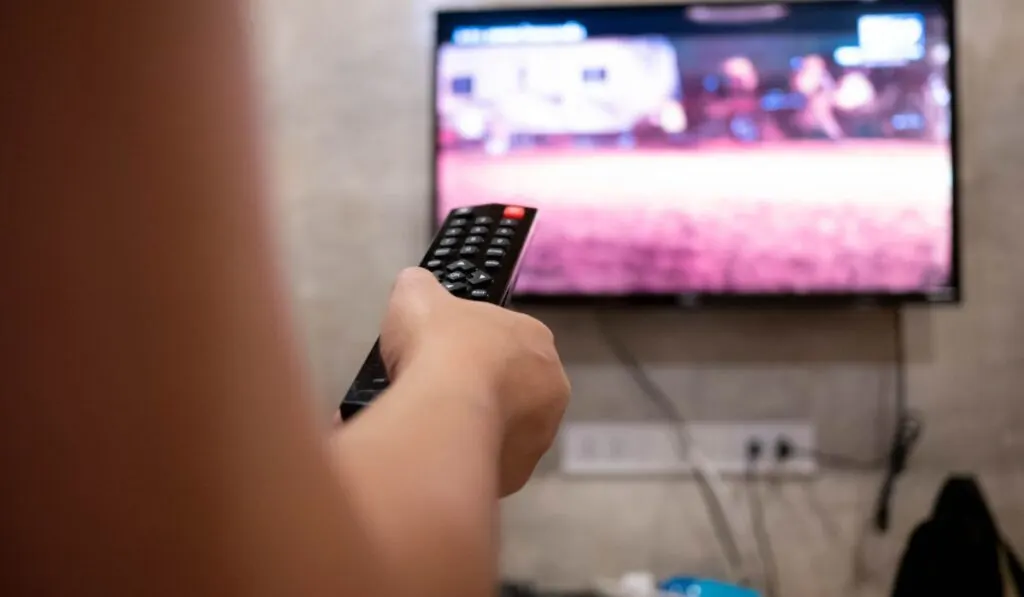Sound is essential when you’re watching TV as it ensures you’re fully immersed in the program and that you clearly understand the dialogue. So it can be pretty frustrating when your TV volume seems too low, even when you have it set at the highest level. Don’t worry; you’re probably not going deaf! But what might be causing the volume to stay so low?
Your TV volume could be low due to incorrect sound settings, remote control issues, or outdated software. You can quickly resolve this issue by configuring the speaker settings, using a different connection cable, or increasing the volume of your set-top box. Make sure your TV isn’t muted!
If your sound is working but too low, we can at least rule out the possibility of hardware damage. Let’s take a look at the possible causes behind the issue and how you can get back to the volume levels you expect from your TV.
Why Is the Volume So Low on Your TV?

Several issues could cause a low volume on your TV. They include:
Wrong Volume Settings
Every TV has a menu full of settings. These configurations are usually factory set and stay the same unless you or someone else changes them. When you change these settings, your TV might experience audio issues.
Sometimes, a cable device or a third-party software can also affect the sound settings, altering your TV’s volume output and making its sound too low.
Remote Control Issues
TVs have remotes with standard controls, like volume up, volume down, mute, channel up and channel down buttons. Sometimes, these buttons can malfunction, resulting in the low volume of your TV.
Outdated Firmware
If a smart TV’s software is outdated, it could cause a TV to misbehave, affecting its sound and picture functionality. A common problem associated with obsolete TV firmware is a loss of video and low audio.
Headphones Might Be Connected
You might have left your headphones plugged into the TV, causing the TV’s low volume. The TV will re-route audio to the headphones as long as they are connected.
Loose TV Cables
Loose TV cables could lead to low volume or total absence of sound from your TV. Dust or material aging can also damage the cables.
How Do You Fix Low TV Volume?
Low TV volume is a common problem with several solutions. Here are a few you can try:
Check the Speaker Settings
Checking your TV speaker is the first and most important step in troubleshooting this issue. It’s possible that you didn’t select an output device, or you may have picked a non-existent one, resulting in the low volume.
You can access the speaker settings by going to the ‘Sound’ tab on the TV settings. Here, you’ll be able to access the ‘Speakers’ tab and find out if the TV speakers are selected as an output audio device.
If they aren’t selected as such, set them and restart your TV, then check if you’ve restored the regular volume.
Perform a Sound Test
You can perform a sound test to diagnose what could be causing the low volume. Here’s how to do it:
- Go to ‘Settings’ and select ‘Support.’
- Choose ‘Self Diagnosis’ and select ‘Start Sound Test.’
If you experience the problem during the sound test, you’ll need to contact your TV manufacturer for expert help.
Turn Off the Simulated Effect
Samsung TVs may come with the simulated effect feature enabled, which could lead to a slightly lower internal volume. This mode makes your TV volume sound low, even at 100.
To disable the simulated effect on your TV, navigate to the sound settings and search for the simulated effect in the available sound features. Select it and slide the blue bar in the opposite direction when you find it. If the bar turns gray, the TV will inform you that you’ve disabled the simulated effect.
Restart your TV and check if this solution has fixed the issue.
Check MTS Configuration
The Multi Television Sound (MTS) settings are responsible for the audio your TV produces when connected to an output device. MTS has two primary features, Main and Stereo, which give out different amounts of volume depending on your output device.
Typically, you’ll find the TV setting on Stereo mode. It’s the simplest configuration and is always active despite the output device. If you have a surround sound system, you should set the TV to ‘Main’ so that all the speakers work.
If you select any MTS features other than Main or Stereo, you might experience sound disruption or complete sound loss, so stick to only those two.
Disconnect and Reconnect the Cable Leading to the External Device
Disconnect the cable linking your TV to the external device, then reconnect it at both ends and confirm if the TV volume is still low. If so, try using another cable to see if it fixes the problem. You could also try a different port on your TV; the one you’re using could be faulty.
Alternatively, you could use the same cable to connect your TV to a different device, and if the volume is loud on the other device, your external device could be the one with the problem.
Increase the Volume on Your Set-Top Box
If you have a set-top box connected to your TV, it splits the volume into portions with both your TV speakers and the set-top box able to control the volume level. Press the volume up button on your set-top box to increase the volume to a desirable level and confirm if it resolves the issue.
If you’ve connected your set-top box to the TV using an AV cable connection, ensure you firmly plug in the cables to the correct video input.
Check the Video Playback
It could also help to check whether the app or video playback is faulty. If your TV is at full volume yet makes a low sound, the video’s or app’s playback might be experiencing problems. To confirm this, play another video to see if the volume increases.
Update Your TV Software
Updating your TV could fix the low volume error if a temporary bug causes it. You can confirm if there are any updates available, then download them. Aside from fixing bugs, updates might also come with new features and keep your TV performing optimally. To update your TV:
- Go to the Settings and select ‘Support.’
- Search for Software updates.
- Download and install the available update file.
- Restart your TV and check if the updates have fixed the issue.
Seek Professional Technical Help
In case you’ve tried everything but the problem persists, it’s best to contact your TV’s manufacturer for expert help fixing the malfunction. If you purchased the TV from a third-party retail store, you could get in touch with them and schedule a repair, or if your warranty card is still valid, they might replace it entirely.
What Is Auto Volume TV?

Auto Volume is a Samsung Smart TV feature used for stabilizing channel sound. Auto Volume helps prevent volume fluctuation as you change the channels when enabled. With this feature, your TV’s volume won’t increase or decrease dramatically each time you select a new channel.
Advantages of Auto Volume
The advantages of the Auto Volume feature are that:
- It keeps your TV volume constant by automatically raising the sound output when the sound modulation signal is low or lowering the sound output when the modulation signal is high.
- It maintains a similar level of volume output on every channel.
How to Enable Auto Volume
Follow these simple steps to enable the Auto Volume feature:
- Press the ‘Home‘ button on your remote control to display the Smart Hub and select ‘Settings.’
- Go to the ‘Sound‘ tab and select ‘Expert Settings.’
- Scroll to ‘Auto Volume’ and press ‘Enter‘ on the remote to turn it on.
